Coolant Flush on a Scion Tc
The coolant on Toyotas and Scions with red coolant should be flushed at about 100,000 miles, and it became time for a coolant flush on the Scion Tc. The process is extremely simple – drain old coolant out, put new coolant in, and burp the radiator. This writeup is primarily to show those unfamiliar where to drain and fill on this car, and what coolant to use.
In the writeup, I don’t do a complete flush – I simply drain and refill the radiator. You can also run water through the engine block and attempt to get everything out, but for a daily driven car like this, I personally think this is sufficient.
Tools Required
- Gloves
- Eye protection (Coolant shoots out pretty fast on this car)
-
Fresh coolant
- Bucket to catch coolant
Tools are minimal; you simply need a phillips head screwdriver,
fresh coolant, and some gloves. The coolant is the only tricky part, as discussed below.
Something important to note here: in case you aren’t aware, antifreeze/coolant is extremely toxic stuff. Definitely wear waterproof gloves to keep it off your skin, wash it off if you touch it, and get any spills up immediately. Coolant tastes sweet, so animals will poison themselves licking it up.
Also, disposal of old coolant varies, so check your local laws. In my area, if you use the public sewer system, you can pour the coolant down the drain. The antifreeze will feed the bacteria at the treatment plant. Don’t do this if you have a septic tank, or it will ruin it. Also, some areas (California, for example) don’t allow this for some reason, and require you to bring it in to a disposal center like you’d do with oil.
Coolant Choice
From the factory, Toyota and Scion vehicles come with red asian coolant, which is supposed to last longer. You can switch to green if you do a complete flush, but if you’re here I’m assuming that’s beyond scope. It’s easiest to just stick with the red stuff – essentially, they don’t mix well. There are some coolants labelled “universal” out there, and they are supposed to mix with anything.
I chose to stick with red. You can also either buy premixed or concentrated coolant. Essentially, the coolant in your car needs to be a mix of antifreeze and water. You can either buy half and half with water already added, or save some money by buying one concentrated bottle and mixing it with your own distilled water. You never want to use tap water in your car’s radiator, aside from emergency situations where it’s overheating. If you put tap water in, the minerals in the water will help accelerate rusting on the inside of your engine block and radiator. You can use the 80 cent distilled gallons of water from Walmart or just buy premixed.
A lot of people will recommend only using Toyota-brand coolant from the dealer. My problem with this is that it’s extremely expensive; a pre-mixed jug of coolant was about $30 the last time I checked, and if I wanted concentrated coolant, I had to order it. In fact, I couldn’t find reasonably-priced concentrated red coolant anywhere, so I gave up. Instead, I got some premixed “Zerex Asian Formula” from NAPA, and it’s worked fine so far. It was about $10/bottle, as I recall, and I needed a bit over a bottle, but now I have extra to top off with.
Draining the Coolant
First, get the front of the car up in the air. I used ramps, but jack stands work too. Obviously, make sure the car is solidly supported before getting under it, including chocking the rear wheels to prevent it from rolling.
Then, with the engine cold, open the radiator fill cap. It’s on the top of the radiator. The picture shows the cap off. If the engine were hot, hot coolant will come bubbling out of the radiator, and you can easily get burned. Don’t be stupid.
Under the car, the first picture shows where the coolant should theoretically come out. It’s at the bottom of the radiator (which you removed the fill cap from a minute ago) towards the driver’s side. I say theoretically because it makes a bit of a mess. I couldn’t find a way to attach any kind of hose before it sprayed everywhere, though – I’m sure there’s a better way to not pee coolant everywhere, but I was only doing this job once, so I just stayed out of the way and cleaned up afterwards carefully. I guess you could put some tubing over the drain plug right after opening it, but I think you’d still make a huge mess.
The second picture shows a bucket placed ready to catch the coolant. You’re only draining the radiator, so it shouldn’t be too much. I still had a second bucket ready when this one overflowed.
The drain plug itself is up from the hole pictured earlier, tucked away a little bit. It’s the white plug pictured. You can simply open it with a gloved hand to begin draining. Be sure to cover exposed skin, as the coolant will immediately come out. Eye protection is also a good idea. So with safety on, you can go ahead and open the plug up and let the coolant drain.
It’s worth looking at the coolant you get out. If it looks milky or has a lot of oily residue on it, that could be a symptom of a head gasket leak or other related issue. If it has some brown crap in it, that is probably rust, and you may want to continue on and do a more thorough flush of your cooling system. In my case, the coolant extracted was really clean compared to other cars I’ve had, despite having not been touched since at least 60,000 miles ago when we bought the car. As such, I went ahead and topped it back up to finish the job.
Refilling the Coolant
Filling the coolant is only complicated by the fact that you have to be sure to “burp” it. Essentially, you don’t want any air bubbles in your car’s cooling system; they can cause it to overheat, read the wrong temperature, and a host of other things. They will naturally dissipate as you drive the car, but you want to get as many major bubbles out as you can before driving.
The way the cooling system works is that there is a water pump attached to your engine that circulates the coolant through the engine, through a tube to your radiator, through the radiator, and back through another tube to the engine again. You have a thermostat between the radiator and the engine, which is essentially a temperature-sensitive valve. When the coolant gets hot, the valve opens up and lets it flow. When it cools back down, it closes up. This makes sure your car can warm up properly in the winter, but doesn’t overheat in the summer.
The procedure is this: with the nose of the car still in the air, you fill the radiator nearly full with coolant and start the car, leaving the radiator cap off. Let the engine idle and warm up, in park. As the coolant gets warmer, it may overflow a little bit. Eventually, though, the thermostat will open, and the radiator’s coolant level will bubble and suddenly drop – air bubbles caught behind the thermostat are released, and coolant is sucked from the radiator. At this point, you can top off the radiator. Let it warm up and cool down a few times, and you should be good. You can turn off the engine and put the fill cap back on the radiator.
Now, the burping procedure will get the major air bubbles out, but more will come out as you drive the car. There is an overflow bottle for the radiator. When the car heats up and the coolant expands, it’s able to push out into the overflow through a tube, so it doesn’t leak. When it cools down again, it sucks coolant back in.
To finish this job, ensure the overflow bottle is up to the full mark, as pictured. Then, drive the car normally. Every day or two, though, especially when you first drive it, be sure to keep topping off the overflow. As small bubbles escape, the level in the bottle will drop.

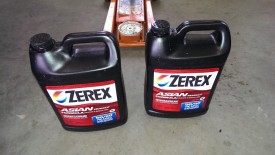
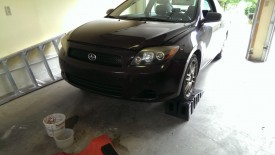
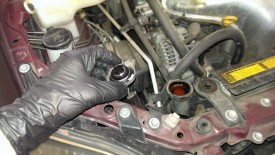
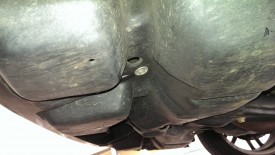
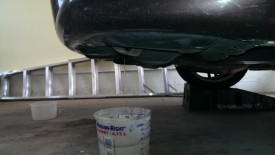
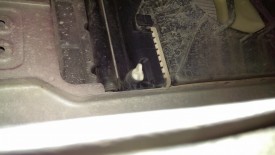
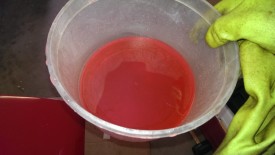
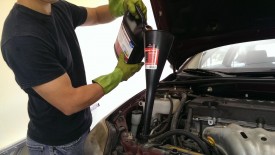

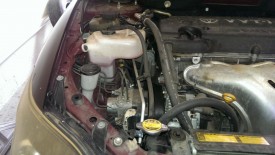
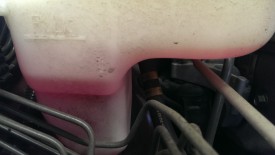
Awesome write up! I’ll be doing this pretty soon and this is a big help! Thank you!
Absolutely, glad to help!